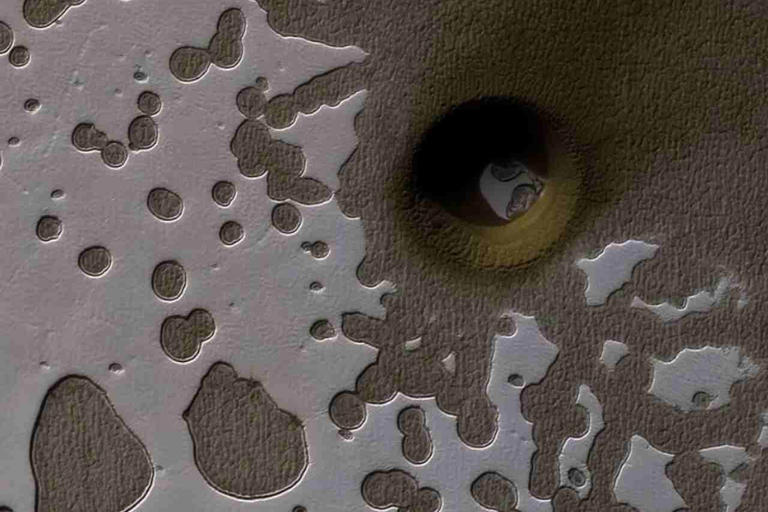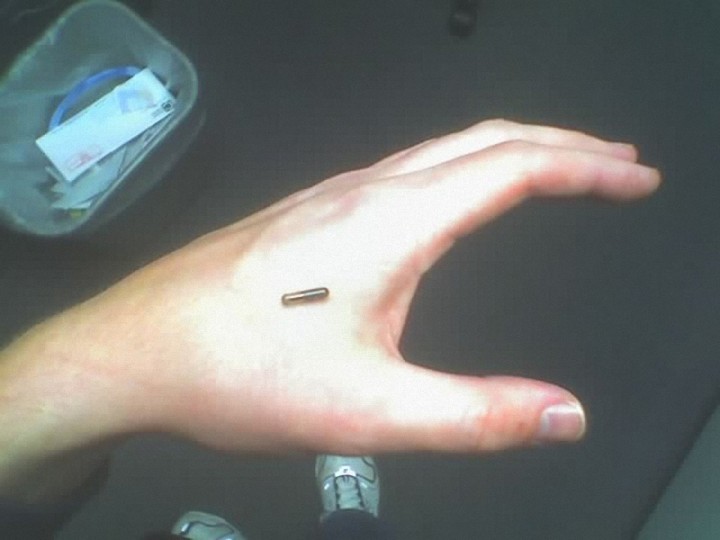In a discovery that’s captivating the scientific world and space enthusiasts alike, NASA has revealed a massive 100-meter deep hole on the surface of Mars that experts suggest could be a possible “gateway” to extraterrestrial life.
This stunning revelation, supported by seasoned astrophysicists and planetary scientists, opens new doors in our search for life beyond Earth—and raises profound questions about what lies beneath the Red Planet’s dusty crust.
A Portal Into the Unknown
The remarkable image, originally captured by NASA’s Mars Reconnaissance Orbiter in 2017, shows a deep, gaping chasm cutting into the Martian surface. Recently re-shared across scientific platforms and social media, the photo has reignited interest and speculation among researchers and the general public.
Unlike the countless craters that pockmark Mars’ scarred terrain, this hole is strikingly different. Its near-perfect circular shape and vertical depth have led experts to believe it might be an entrance to a vast underground network of lava tubes or caverns. These subterranean spaces, largely shielded from Mars’ harsh surface environment, could serve as havens for microbial life—or even more complex organisms.
According to astrophysicist Dr. Robert Nemiroff of Michigan Technological University and senior astronomy lecturer Dr. Jerry Bonnell of the University of Maryland, such formations hold significant promise for future exploration. In a statement accompanying the image on NASA’s Astronomy Picture of the Day (APOD), they explained, “Holes like this are of particular interest because they can be entrances to lower levels leading to extensive underground caves. If this is the case, then these natural tunnels are relatively protected from the hard surface conditions of Mars, making them good candidates for hosting Martian life.”
Why Mars Caves Are Crucial for Space Exploration
Mars, often referred to as Earth’s “sister planet,” has long fascinated astronomers as a candidate for life. But its surface is an inhospitable wasteland of radiation, extreme cold, and unrelenting dust storms. This makes the search for life on the surface incredibly challenging. That’s why discoveries like this hole are game-changers.
Underground caves and tunnels provide natural protection from cosmic radiation and temperature extremes. They could also preserve water ice and offer clues to ancient microbial ecosystems that may have existed when Mars was warmer and wetter billions of years ago. More intriguingly, they might still harbor life today, shielded from the harsh realities above.
These cavities are not just important for science—they’re vital for the future of human space travel. Potential manned missions to Mars could use such underground shelters as natural habitats, reducing the need to build surface structures from scratch. NASA and other space agencies, including SpaceX, have already expressed interest in leveraging natural formations for sustainable exploration and colonization.
How Did the Hole Form?
Although the exact origin of this Martian pit remains uncertain, scientists believe it may have formed due to a meteorite impact or the collapse of an ancient lava tube—both common geological phenomena on Mars. Lava tubes are created when flowing lava hardens on the outside while the inner molten rock continues to flow, eventually leaving behind a hollow tunnel.
The image of this particular hole shows steep, shadowed walls that seem to drop vertically into darkness. The lack of debris around the entrance suggests that it could be a vertical shaft into an empty cavity, rather than just a simple depression caused by erosion or collapse.
Viral Impact and Public Fascination
After NASA re-shared the image on its official social channels, it quickly went viral—especially after being featured by the popular Instagram account @astronomypicturesdaily. Thousands of users commented on the potential implications of the discovery, with many comparing the Martian pit to science fiction depictions of alien gateways or hidden bases.
Adding to the intrigue is the timing: this resurgence of interest in Mars comes as several space agencies prepare for ambitious new missions, including potential sample-return missions and the eventual deployment of human crews. Could this hole become the focal point of future Martian exploration?
The Next Steps in the Search for Life
NASA and other global space agencies are already working on missions that will explore subsurface environments. Rovers equipped with ground-penetrating radar and autonomous drones could one day enter these Martian caverns and send back data on their composition, structure, and possible biosignatures.
The 100-meter hole could become one of the most significant sites in that effort. Whether it reveals fossilized microorganisms, microbial colonies, or simply new insights into Martian geology, its scientific value is indisputable.
From Curiosity to Discovery
This colossal Martian hole isn’t just another crater—it might be a beacon pointing toward one of humanity’s most sought-after answers: Are we alone in the universe?
While we are still far from a definitive answer, this discovery underscores the need for continued exploration and innovation. With cutting-edge technology and international collaboration, we inch closer to unlocking the secrets buried beneath the Martian surface.
Stay tuned, because the next big leap in our cosmic journey might just begin with a single hole on a red and silent world.
Photo and Video Source: Instagram @astronomypicturesdaily
Featured Experts: Dr. Robert Nemiroff (MTU) & Dr. Jerry Bonnell (University of Maryland)

















